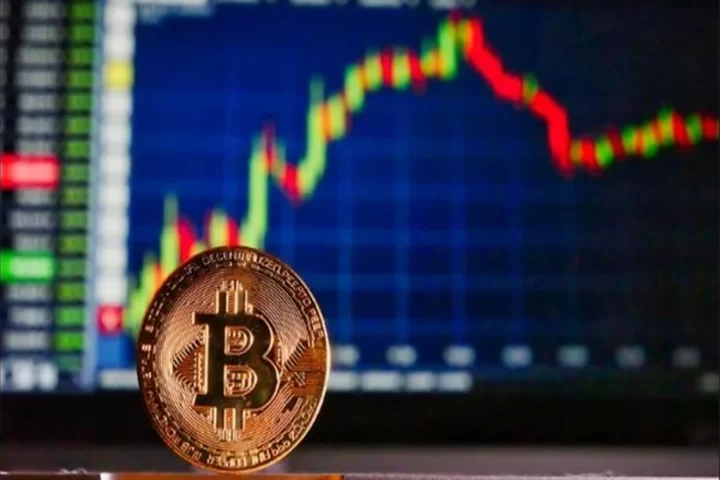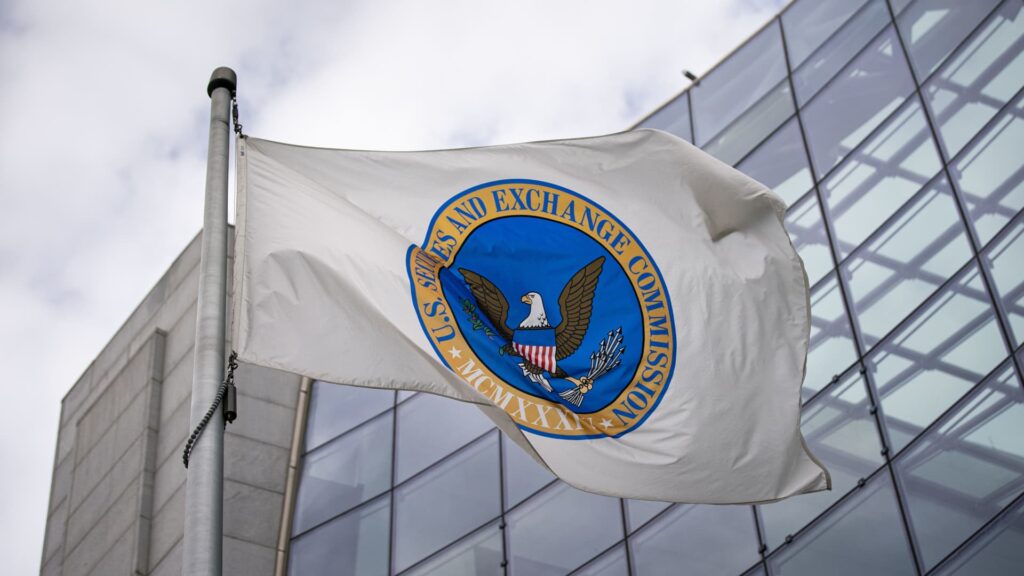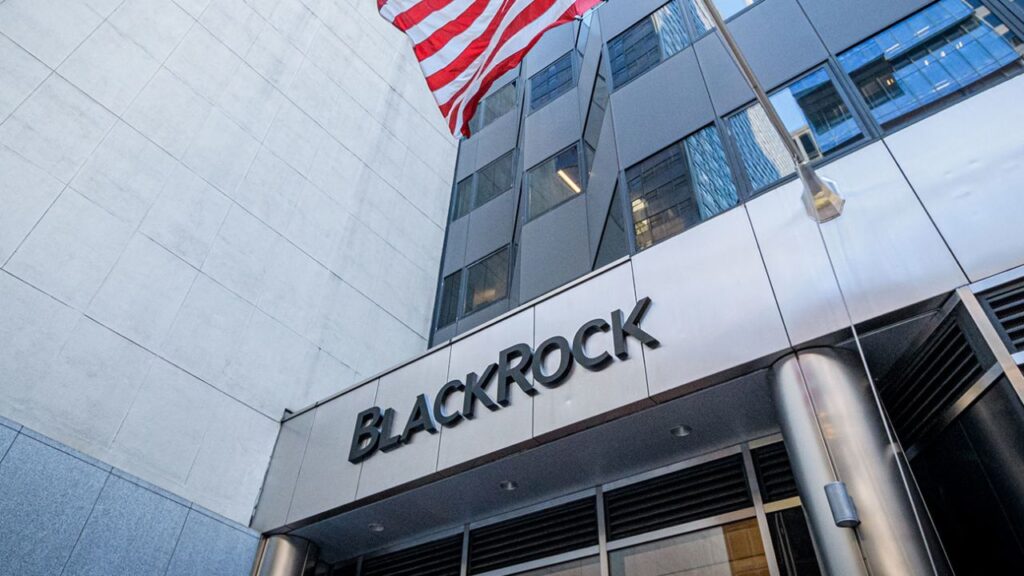On 8th February, spot Bitcoin exchange-traded funds (ETFs) encountered their third-largest surge, amounting to £403 million.
The substantial inflow occurred despite over £100 million exiting the Grayscale Bitcoin Trust (GBTC).
The total influx into spot Bitcoin ETFs has surpassed £2.1 billion since their introduction on 11th January, indicating robust demand for BTC in the market.
The third-largest inflow day for spot BTC ETFs coincided with BTC’s price surpassing $46,000 to mark a fresh multiweek high, just £2,000 shy of new yearly highs.
Leading the ETF flow chart is BlackRock iShares Bitcoin Trust (IBIT) with an inflow of £204 million, followed by Fidelity with £128 million, ARK 21Shares with £86 million, and Bitwise with £60 million.
The remaining seven ETFs collectively witnessed £27 million in inflows, while GBTC recorded another £102 million in outflows.
IBIT also clinched the distinction of becoming the first ETF to surpass GBTC’s daily trading volume.
Nonetheless, the total trading volume of all 11 spot Bitcoin ETFs dipped below £1 billion for the first time since their inception.
READ MORE: US Cryptocurrency Mining Leaders Raise Concerns Over Emergency Energy Survey
Bloomberg senior analyst Eric Balchunas underscored BlackRock’s overtaking of Grayscale in trading volume as a significant achievement, noting that it typically takes about five to 10 years for a new fund to surpass the category’s “liquidity king.”
Market analysts interpret the positive flow into Bitcoin ETFs as indicative of investors’ appetite and burgeoning demand.
The net flows into the ETFs imply that approximately £403 million, or roughly 8,698 BTC, was withdrawn from the market and transferred into cold storage.
Spot Bitcoin ETFs received approval from the United States Securities and Exchange Commission for listing on 10th January and commenced trading the following day.
Since their launch, spot BTC ETFs have witnessed record trading volumes, with over a billion dollars traded daily, indicating robust investor interest.
The forthcoming Bitcoin halving is less than 70 days away, which will halve the market supply of BTC from 6.25 BTC per block to 3.125 BTC.
With mounting demand from institutional investors, the dwindling supply could propel BTC to reach new market highs.
The United States Securities and Exchange Commission (SEC) has implemented new regulations, effective February 6, redefining the terms “dealer” and “government securities dealer.”
Initially proposed in 2022, these regulations mandate additional crypto market participants to register, join self-regulatory organizations, and adhere to federal securities laws.
However, the crypto community, decentralized finance (DeFi) ecosystem, and pro-crypto politicians have criticized these regulations extensively.
They argue that since the regulations were first proposed, there has been a lack of clarity regarding the classification of crypto securities.
The primary point of contention lies in the definition of a dealer, potentially necessitating liquidity providers to register as securities dealers.
Consequently, any liquidity provider controlling over $50 million in capital would be obligated to register with the SEC.
SEC Commissioner Hester Pierce expressed her dissent in an official statement, citing the inconsistency of the dealer definition with the statutory framework and its adverse effects on market behavior and quality.
She emphasized that these regulations not only harm liquidity providers but also penalize liquidity provision, leading to a reduction in overall market liquidity.
READ MORE: South Korean Prosecutors Arrest Haru Invest Executives in $830 Million Crypto Theft Scandal
Various figures within the DeFi sector and crypto domain have echoed concerns over these regulations on social media.
Gabriel Shapiro, general counsel at Delphi Labs, highlighted uncertainties surrounding the dealer registration requirements and their impact on liquidity providers.
According to Shapiro, not all liquidity providers with $50 million assets under management qualify as securities dealers.
The determination depends on whether the tokens in the pool or the trades facilitated through the pool are classified as securities.
Bill Hughes, senior counsel and director of global regulatory matters at Consensys, stressed the importance of clarity regarding the classification of crypto assets under U.S. law.
He anticipates legal challenges to the new rules, emphasizing the significant impact they have on the securities markets.
Moreover, the SEC’s reluctance to provide clear crypto regulations despite persistent demands from the community and policymakers has drawn criticism.
Ripple, Grayscale, and Coinbase have all challenged the SEC’s actions in court, indicating a broader pushback against regulatory ambiguity.
Experts suggest that the recent regulations targeting liquidity providers may also face judicial scrutiny in the future.
On February 7, the total daily trading volume for spot Bitcoin exchange-traded funds (ETFs) surpassed a billion dollars, with BlackRock taking the lead.
Bloomberg Intelligence analyst James Seyffart noted a significant surge in trading activity for BlackRock’s iShares Bitcoin Trust (IBIT), which amassed a daily trading volume of $341.2 million, outstripping the Grayscale Bitcoin Trust’s $296.5 million, according to Seyffart’s analysis.
Fidelity’s FBTC fund secured the third position with a trading volume of $200 million, while the remaining seven funds collectively contributed $188 million, culminating in a daily trading volume exceeding a billion dollars.
Despite this milestone, Seyffart downplayed its significance, stating that surpassing the billion-dollar mark “isn’t that big of a deal” for Bitcoin ETFs.
He clarified that while it represented an increase from recent days, it still fell short of the initial trading weeks.
READ MORE: Crypto Wallets Tied to FTX and Alameda Transfer $38.8 Million to Exchanges Since January 2024
In a notable trend, inflows into spot Bitcoin ETFs have consistently outpaced outflows from GBTC for the ninth consecutive day.
On February 7, preliminary data from Farside revealed $81 million in outflows from GBTC, contrasted with $226 million in inflows across the other nine spot Bitcoin ETFs, resulting in net flows of $145 million.
BlackRock witnessed an inflow of $56 million, Fidelity’s fund saw an increase of $130 million, and Bitwise experienced inflows of $21 million.
On February 8, investor and author Fred Krueger highlighted a significant observation: the combined BTC holdings of the newly launched nine ETFs were poised to exceed those of MicroStrategy, the largest corporate holder of the asset.
The ETF funds collectively held approximately 187,000 BTC as of February 7, slightly below MicroStrategy’s holdings of 190,000 coins valued at over $8 billion.
In a related development, it was reported that Fidelity had begun allocating spot Bitcoin to their All-in-One Conservative ETF. ETF analyst Eric Balchunas regarded this move as a positive sign, particularly in the conservative investment domain.
BlackRock’s iShares Bitcoin Trust exchange-traded fund (ETF) has swiftly ascended into the upper echelon of U.S.-issued ETF products, ranking in the top 0.16%.
As of February 5th, the ETF has attracted over $3.19 billion in inflows, trailing only behind broad index funds tracking the S&P 500 and Vanguard’s Total Stock Market ETF, as reported by Eric Balchunas, a senior ETF analyst at Bloomberg.
Remarkably, within just 17 days since its inception, $IBIT has surged into the Top 5 in year-to-date flows, surpassing 99.98% of other ETFs.
Comparing against the 3,109 ETFs presently trading in the United States, BlackRock’s ETF stands out, placing in the top 0.16% in terms of flows.
Balchunas offers a slightly different assessment, suggesting a 0.02% position when measured against an estimated 10,000 ETFs globally.
Fidelity’s Bitcoin Fund follows closely behind, securing the eighth spot among U.S.-based ETF products with $2.51 billion in inflows.
Both BlackRock and Fidelity’s Bitcoin ETFs have steadily climbed the ranks, advancing from eighth and tenth positions at the end of January.
READ MORE: ‘Very Few Speak of the Crypto Winter, Bitcoin is Rising in 2024’ – Serhii Tron on Crypto Investments
Notably, the approval of spot Bitcoin ETF products for trading on January 11th puts them at a seven-day trading disadvantage compared to other products whose flows are tallied from January 1st.
BitMEX Research data highlights the widening gap between BlackRock and Fidelity’s spot Bitcoin ETFs against seven other spot Bitcoin ETFs (excluding Grayscale) in terms of inflows.
ARK 21Shares and Bitwise secure third and fourth positions respectively, with over $100 million in accumulated flows each.
Meanwhile, Grayscale’s converted spot Bitcoin ETF, the Grayscale Bitcoin Trust (GBTC), saw a decline in outflows for the sixth consecutive day, recording $73 million on February 6th.
Notably, inflows from other Bitcoin ETF issuers have consistently outpaced outflows from Grayscale’s GBTC for at least seven consecutive days, marking a significant shift in investor sentiment.
The latest outflow figure represents an 88% decrease from GBTC’s peak outflow day on January 22nd, signaling a changing landscape in the Bitcoin ETF market.
Grayscale CEO Michael Sonnenshein has urged regulators to approve exchange-listed options for spot Bitcoin exchange-traded funds (ETFs) in a recent post on February 5.
Sonnenshein highlighted the importance of options in supporting price discovery and assisting investors in navigating market conditions and achieving desired outcomes, such as income generation.
Exchange-traded options represent standardized contracts allowing investors to buy (via call options) or sell (via put options) a specific quantity of a financial asset at a predetermined price (strike price) on or before a specified date.
This enables investors to make predictions about the future movements of stocks, bonds, and the overall stock market.
These options are traded on exchanges like the Chicago Board Options Exchange (Cboe) and are subject to regulation by the United States Commodity Futures Trading Commission (CFTC) and the Securities and Exchange Commission (SEC). Clearinghouses like the Options Clearing Corporation (OCC) provide guarantees for these exchanges.
Sonnenshein pointed out that when the SEC approved the first Bitcoin futures ETF in October 2021, options for the ETF were available for trading the very next day due to automatic effectiveness, leveraging existing rules.
READ MORE: FTX Bankruptcy Raises Questions Over Legal Team’s Lucrative Fees
However, this rule does not apply to commodity-based ETFs, including recently approved spot Bitcoin ETFs, which undergo a potentially lengthy review process akin to the 19b-4 process for spot Bitcoin ETFs themselves.
The Grayscale CEO advocated for equal treatment of similar financial products, drawing parallels between spot and futures BTC-based ETFs.
He highlighted that national exchanges, such as the New York Stock Exchange, have filed Forms 19b-4 to amend listing standards, allowing listed options on commodity-based ETFs, including spot Bitcoin ETFs.
Currently, the SEC is reviewing applications for listed options on spot BTC ETFs and has opened comments on BlackRock’s proposed options with Cboe.
Bloomberg ETF analyst Eric Balchunas suggested that the SEC could make a decision as early as February 15 or no later than September 2024.
Sonnenshein concluded his post by emphasizing the need for fair treatment of spot Bitcoin ETFs and the entire crypto asset class.
His advocacy aims to ensure that investors have access to a broader range of financial products and options, promoting transparency and market efficiency.
Serhii Tron, founder of White Rock Management, one of the largest mining companies in the world, spoke on the current state of the crypto market, and shared his vision of what comes next this year
What are the most valuable lessons we can learn from 2023?
What’s most important – and quite obvious for everybody – is that the crypto winter, the topic that so many people fueled their devastating forecasts with in 2022, is over and done with. A stone-cold fact, which I am not sure why anybody has any reason to question. The market did have to plough through a lot, but last year, the price of bitcoin leapt by 150%, and hit a $44 thousand mark. There were, of course, some corrections and fallbacks, however, the outcome is still very much on the bright side, so there are few people bringing up the $17 thousand indicator from November 2022.
BTC capitalization once again exceeded $816 billion. If you look at the entire market, you can see the capitalization growth of 2023 was a solid 108.1% – from $829 billion to $1.72 trillion, with the annual trade volumes reaching $36 trillion. Doesn’t feel like winter to me.
Were the external factors involved?
Naturally, there were many things at play, for the crypto market does not exist by itself. Back in 2022, world regulators had to handle the aftermath of the COVID-19 pandemic and forced monetary emission (to help businesses stay afloat and keep the wolf of the global crisis at the door) – monetary policies had to tighten in order to keep the global inflation at bay. Very active in this endeavor was the U.S. Federal Reserve, which raised their basic rates. But, by the end of 2023, the Feds softened a bit, with the consumer prices gradually going down.

Two major events took place in the United States: at the year’s start, the state regulator had to interfere and save the banks in distress (Silicon Valley Bank, Signature Bank) by means of its own Bank Term Funding Program (BTFP), which basically means a lot of money (around $400 billion) had to be pumped into the failing institutions; as the monetary policies eased up a little, the said money incrementally spread across the markets. For the loan and stock markets, and crypto market to boot, the money influx worked like a charm. Dollar instruments’ profitability decreased, but it went up in our segment, hence it feels like a natural order of things, all things considered.
Declining unemployment rates across the world and GDP growth were some other positive factors. Geopolitical tensions are still on the rise, though. I’m speaking about not only military actions in Ukraine and Israel, but the attacks on ships in the Red Sea, and bad blood between North/South Korea, and China/Taiwan.
On the bright side, people happened to notice the financial regulators are pretty interested in crypto. I am, of course, talking about the scandals and law suits against several crypto-dealing enterprises after FTX closure, which made a lot of market players really worried. Some even said it was about to bring the eternal winter upon our market. Which did not happen, by the way, as we soldiered on. I believe that, at least in part, it was possible thanks to the settlement that one of the world’s largest platforms Binance agreed to. Even though the company was fined, this solution is widely considered the optimal choice under the very tricky circumstances. The court hearings on another stock market (Coinbase) are still afoot, but we stay hopeful that both sides can also come to an agreement.
Do you think the state authorities will keep on pushing?
Most certainly, yes. Not in a bad way only, though, by imposing even more pressure and limitations. We can see that many regulators remain unmoved, and are dead-set to not accept crypto for what it is. However, it is pretty much common understanding that digital assets are the future. It doesn’t need to be fought; it needs to be reasonably regulated instead.

Yes, the regulations must be reasonable: measures of control need to be in place so that bitcoin and other coins are not used in arms deals and drug trade; the investors need to be protected from scoundrels and thieves. That being said, excessive regulations need to perish, for they only hold back development of the market and some necessary instruments.
Are you now speaking of the 10-year war with the U.S. regulator for BTC ETFs?
I’m now speaking in general. Surely, BTC ETFs implementation in the United States took way longer than it should have, and it definitely should have happened much sooner. However, hats off to the U.S. Securities and Exchange Commission (SEC) for what they did in January 2024. The entire market has been anticipating this move since the summer of 2023, when BlackRock applied for this instrument after the watershed court ruling in the Grayscale Investments case: this one company was the sole most persistent proponent of this instrument, and basically served as a trailblazer for the market as a whole.
I would like to point out, though, that many political figures warmed up to the crypto market last year. Robert Francis Kennedy Jr. (nephew of the legendary 35th U.S. President JFK), Democratic Party member and U.S. presidential candidate, openly supported crypto, and was the one to admit that bitcoin can back up the dollar exchange rate; he also compared BTC to gold. A lot was done in terms of lobbying and legislation by the U.S. Senator (Rep) Cynthia Lummis. Another vocal supporter of crypto is Javier Milei, the new President of Argentina, who’s put his team on a mission of crypto popularization in his home country. There are more politicians in favor of cryptocurrency: Lichtenstein’s Prime Minister, Minister of Finance Daniel Risch, leader of the Polish party “Porozumienie” (previously “Polska Razem”) Jarosław Govin, and many more political figures, who from their high chairs and offices substantiate the importance of digital assets. More importantly, they take real measures for coins integration.
In my home country of Ukraine, the work on legislative regulations has intensified. Before the full-scale invasion, one specialized law was adopted and signed (“The Law on Virtual Assets”), with one more piece of legislation in the works, which touches upon taxation, regulations, and other minor details. Several drafts have been introduced so far, with ongoing debates in full swing – which is always helpful; I expect the authorities to pay attention to the field experts and find common ground. Despite the sad reality of a fully-fledged atrocious war, popularity of BTC and other coins is only rising: Ukraine is No. 5 (preceded by the United States) on the Chainanalysis list of countries embracing crypto assets. According to this list, we beat Brazil, China, and Turkiye. Once we win this war, and once the legislation is sorted out, BTC in Ukraine will skyrocket.
Even under such conditions, Ukrainian crypto business keeps moving forward, including foreign countries. What are the objectives of your company?
My personal goals at the moment are to make White Rock Management one of the world’s top-3 miners, and make our company public. We are prepared to enter new markets and attract capitals. From day one, we designed our business in a way to be very clear and understandable to our investors. We imposed our principle from the very start (Environmental, Social, and Corporate), and we never messed with loans, which many of our colleagues do; thus, they’re up to the neck in debts.
We might fall short in terms of mining volumes, however, we’re not reliant on massive loans. We have zero debts and optimal EBITDA, which can be proven by three consecutive years of successful audits by international experts. I am certain that we’ll attract a lot of interest.
We are actively developing several projects in Canada and South America. Investment-wise, we’re talking about $100+ million. Also, alternative energy sources, green energy in particular, are one of our top priorities, and we have no intention of pulling back on this path.
This is, by the way, one of the reasons why miners face heavy criticism – excessive energy consumption (competing for it with other industries), especially in the middle of winter in regions burdened with all sorts of troubles…
State authorities of many countries have previously attacked the mining community as our industry was maturing, with some even launching full-scale propaganda campaigns against crypto: they claimed we’re parasites that stand in the way of developing economies. However, it was the miners who turned out to be the most prolific investors in alternative energy sources. Therefore, this angle of critique is no longer valid. There still might be some local complaints in specific regions, yet they are few and far in between.
No other field but crypto does as much to keep the green energy sector in motion. When I meet my colleagues, I find out about new projects on alternative energy sources that are being developed non-stop: for example, Bitfarms representatives spoke very engagingly on the use of hydro power in Norway, Finland, and Sweden, while Bit Digital is powered by the Niagara River in the USA (electric power generated by the currents of the Niagara River); some of our colleagues put to use geothermal power in Iceland. Our own White Rock Management is an avid proponent of hydro energy, but we are also very interested in American projects (Texas) in gas flaring, which help reduce CO2 emissions at the same time. We joined another 250 companies in signing the Crypto Climate Accord agreement that stipulates environmentally friendly and safe mining of crypto.
Do you think this subject will remain in demand in 2024? What is your general forecast for this year?
Yes, I am confident that environmentally friendly projects will remain popular among the miners – I know we’ll keep working on them for sure. This is right, and this is profitable, too, if you make your business work correctly.
Speaking of the crypto market as a whole, a lot will revolve around those new instruments and opportunities for the investors. I am, of course, talking about BTC ETFs that had a pretty solid start in the United States despite the Grayscale sale-off (Grayscale Bitcoin Trust), which people saw coming to begin with. The major share of stock exchange spots ended up in the liquidator’s pocket, FTX, which never denied it was after maximizing profits to pay off the creditors. Sooner or later, these sale-offs will come to an end, with more money gradually flowing into other funds.
I am sure the investments will grow, including the numbers from the retail market. Back in late-January, Google posted first ads of BTC ETFs, a move that will most certainly attract attention of general public across the board. New funds will emerge, not in the U.S. alone: not so long ago, a spot application was filed in Hong Kong, and I’ve faith it will come through. Let’s wait and see when Europe kicks this door flying open, for the big party is yet to start around here. Capitalization and trading volumes will grow, make no mistake about that.
Surely, other products will pass various stages of development too. 2023 saw significant interest in AI-generated tokens (AI segment of the crypto market exceeded 11%), GameFi and even meme-coins – something a lot of us managed to forget about entirely. But, speaking of the mass market, I am sure the lion share of attention will be dedicated to BTC ETFs.
Readers are always curious about expected rates of the main cryptocurrency of all…
I’m not keen on putting exact numbers on things, however, I am confident the price of bitcoin will keep on rising. With some fallbacks and profit locking, perhaps, but still on the rise overall. There are objective reasons for the upward dynamics.
I have mentioned the further expansion of BTC ETFs, which will perpetuate the increasing value of the coin. Let us not forget about another major event, the halving, which will most definitely affect the exchange rate fluctuations. Also, willingly or otherwise, the stimulation of the interest in BTC will depend on the world’s financial regulators that are on the path of easing their monetary policies. U.S. Federal Reserve in particular: American regulator kept the basic rates as they were (5.25-5.5% per annum), but might lower them in this coming March, as inflation retreats and employment rates improve. The next thing to happen will be a natural reaction: a decrease in the profitability of dollar instruments, and an easy flow of capital from the credit and stock markets to the cryptocurrency market, which promises more interesting earnings. This wheel will spin itself, and we will see the price of crypto rise.
Many analysts insist that by the end of the year’s first quarter or beginning of the second, bitcoin will comfortably sit around $50-60 thousand apiece. Who knows, though: should the stars align perfectly, this price tag might be even better.
South Korea’s Financial Supervisory Service (FSS), the primary financial regulatory authority in the country, has unveiled its plan to seek insights from the United States Securities and Exchange Commission (SEC) regarding spot Bitcoin exchange-traded funds (ETFs).
The FSS is responsible for overseeing and regulating financial institutions under the broader jurisdiction of the Financial Services Commission.
On February 5, FSS Chief Lee Bok-Hyun presented the organization’s business plan for 2024 in Seoul.
As part of this plan, the FSS intends to visit major advanced financial markets, including New York, during the second quarter of the year.
The primary focus of these visits is to engage in discussions concerning various aspects of South Korean financial markets, with a specific emphasis on spot Bitcoin ETFs, according to reports.
Chief Lee also disclosed his intentions to meet with SEC Chair Gary Gensler later in 2024 to discuss digital assets and, notably, spot Bitcoin ETFs, among other financial matters.
He underscored the significant influence of the SEC’s recent approval of spot Bitcoin ETFs on global financial policies.
This announcement comes shortly after the SEC’s groundbreaking decision to greenlight 11 spot Bitcoin ETFs on January 10, marking the first-ever approval of such ETFs in the United States.
Previously, the SEC had rejected spot Bitcoin ETF applications, citing concerns about the crypto market’s relatively small size and susceptibility to market manipulation.
READ MORE; FTX Seeks Court Approval to Sell Anthropic Stake Amidst Bankruptcy
Following the SEC’s approval of spot BTC ETFs, the Korean securities regulator cautioned local firms against facilitating spot Bitcoin ETF transactions from the United States.
However, they also signaled their intention to review and update their regulatory framework pertaining to spot Bitcoin ETFs traded in the United States.
South Korea has established itself as a prominent regulator in the Asia-Pacific region when it comes to cryptocurrency markets.
The country often takes cues from the United States with regard to crypto regulations, including measures like prohibiting the use of credit cards for crypto purchases and banning crypto mixing services.
This ongoing collaboration with the SEC underscores South Korea’s commitment to staying current with evolving global crypto trends and regulations.
ProShares, a prominent issuer of futures-based Bitcoin exchange-traded funds (ETFs), remains unfazed by potential threats associated with the introduction of spot Bitcoin ETFs in the United States, according to a senior executive.
Simeon Hyman, ProShares’ global investment strategist, expressed that the company perceives advantages in the launch of spot Bitcoin ETFs for its futures products, both from operational and commercial perspectives.
In an interview with Cointelegraph on February 2, Hyman noted that their flagship Bitcoin futures ETF, the ProShares Bitcoin Strategy ETF (BITO), has experienced “very efficient” trading volumes since the arrival of spot Bitcoin ETFs.
Hyman conveyed the company’s satisfaction with BITO’s commercial impact, revealing that it currently trades with a mere two basis points deviation (2/100th of a percent) from its underlying value.
In contrast, spot ETFs have displayed an average premium or discount of 36 basis points.
Beyond the commercial realm, ProShares anticipates operational benefits stemming from the increased adoption driven by spot Bitcoin ETFs.
Hyman explained that the presence of spot ETFs is enhancing the futures market, which was already well-functioning and regulated.
The increased activity around Bitcoin is seen as a positive development.
READ MORE: FTX Bankruptcy Raises Questions Over Legal Team’s Lucrative Fees
These statements align with BITO’s recent trading dynamics, except for an abnormal spike in trading volume on January 11, coinciding with the launch of spot Bitcoin ETFs.
On that day, BITO’s trading volumes soared to nearly $2 billion, while its typical volumes ranged between $300 million and $600 million.
However, since the introduction of spot BTC ETFs, BITO has returned to its usual trading figures, reaching as low as $180 million on February 2. Prior to the spot ETFs’ launch, it traded within a similar range, as indicated by Yahoo Finance data.
It is worth noting that the news arrived as major spot Bitcoin ETFs like BlackRock’s iShares Bitcoin Trust (IBIT) and the Grayscale Bitcoin Trust ETF (GBTC) temporarily surpassed BITO in trading volumes, marking a significant shift.
BITO had previously held the title of the world’s largest Bitcoin ETF in terms of trading volumes.
Launched in October 2021, BITO stands as the United States’ first substantial futures Bitcoin ETF.
In contrast to spot Bitcoin ETFs, which track actual Bitcoin holdings, ProShares’ BITO uses futures contracts as its underlying asset.
Despite the changing landscape, ProShares remains optimistic about the future of its futures-based Bitcoin ETF amid the growing interest in the cryptocurrency market.
On February 5th, Bitcoin experienced a surge, surpassing the $43,500 mark, coinciding with the opening of Wall Street, as U.S. markets reacted to tumultuous events in the Chinese stock market.
Bitstamp reported local highs of $43,515 for Bitcoin, marking a new record for the cryptocurrency’s price in February.
This price rally was ignited by the abrupt drop of 8% in China’s CSI 1000 index, prompting Chinese authorities to enforce stricter controls on short selling.
Concerns about a potential recession in China began to circulate, with observations of a “disconnect” between large and small-cap stocks, causing China’s market to lose an astounding $7 trillion in value over the past three years.
Bitcoin’s volatility was further fueled by a significant increase in open interest, reaching $775 million, as reported by J. A. Maartunn, a contributor to the on-chain analytics platform CryptoQuant.
Despite the volatile market conditions, outflows from the Grayscale Bitcoin Trust (GBTC) remained relatively low, with approximately 2,600 BTC leaving the trust, continuing a downward trend seen in previous days.
Keith Alan, co-founder of the trading tool Material Indicators, analyzed the order book composition and issued a cautionary note regarding Bitcoin’s price.
He highlighted that there was limited liquidity immediately below the current spot price, making a drop to $42,000 appear quite plausible.
Furthermore, Alan noted that liquidity was more abundant around the $25,000 range, indicating growing sentiment for a potential price dip.
READ MORE: Artists Ryder Ripps and Jeremy Cahen Ordered to Pay $9 Million in BAYC NFT Lawsuit
He emphasized the relationship between liquidity and sentiment, explaining that increased liquidity often reflects prevailing market sentiment.
Alan also pointed out that the ladder of ask liquidity above the current spot price was gradually decreasing, suggesting that a rapid ascent to $45,000 or higher in the short term was unlikely.
In summary, Bitcoin’s price surged to over $43,500 as a response to the turmoil in the Chinese stock market.
This spike was accompanied by increased open interest and relatively low outflows from the Grayscale Bitcoin Trust.
However, caution was advised due to limited liquidity below the current price, with the potential for a dip to $42,000.
Overall, market sentiment remained uncertain, with the possibility of further price fluctuations in the near future.
According to a recent analysis by DecenTrader, Bitcoin is expected to reach new all-time highs in 2024, but not without some challenges along the way.
The analysis, released on February 2nd, suggests that Bitcoin’s price behavior will follow a typical pattern during a “halving year.”
DecenTrader predicts that Bitcoin will experience about a month of sideways price movement before the market reacts to the upcoming block subsidy halving.
CEO and co-founder Filbfilb explains that investors should anticipate a surge in buying activity approximately two months before the halving, which is currently estimated to occur on April 18.
However, following this buying surge, there may be another “sell the news event,” similar to what happened when spot Bitcoin exchange-traded funds (ETFs) were launched in January.
Filbfilb points out that there are roughly 75 days remaining until the Bitcoin halving, suggesting that buying interest is likely to start no later than six weeks before the event, or around the second week of March.
This anticipation among speculators could drive Bitcoin’s price to its current two-year high of $49,000 before a sell-off resembling the ETF launch occurs.
Nevertheless, the path ahead appears promising, as price discovery is expected to happen before the end of 2024, similar to the outcome of Bitcoin’s last halving year in 2020.
READ MORE: European Union Achieves Landmark Approval of AI Regulation with EU’s AI Act
Filbfilb advises investors to be aware that Bitcoin tends to front-run the “sell-the-news” phenomenon associated with halving events.
Despite the optimism surrounding Bitcoin’s potential for a new all-time high, the first quarter of 2024 may be challenging for traders.
In addition to Bitcoin-specific factors, macroeconomic and geopolitical uncertainties could contribute to wider risk-asset turbulence.
Concerns include the weakness of the United States banking system, which former BitMEX CEO Arthur Hayes expects to come to a head in March.
Some analysts even believe that Bitcoin may not reach a new all-time high until the end of 2025.
Filbfilb remains cautious and warns against excessive optimism, emphasizing that previous market cycles in Bitcoin have followed a consistent pattern driven by investor emotions.
As Bitcoin traded just under $43,000 into the February 4th weekly close, the cryptocurrency market’s trajectory remains uncertain, with various factors influencing its future performance.









